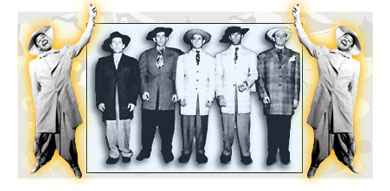Zoot suits

Fashion Synopsis
“Hey Pachuco!”
The wildest swinging suit on the scene, the zoot suit was for the craziest of cats, ya dig alligator? Unlike the boxy and square business suit, the zoot was for looking swank. When you went out to swing with the likes of Cab Calloway and his band, you got dolled up in your best drapes, shined your two-tone kickers, smoothed your wide brimmed, pancake hat and fluffed your feather.
“Zoot” was already common street slang for extravagance, and when a highly exaggerated suit of wide lapels, deep pleated pants and wide-brimmed hats walked down the street in the late 30’s, zoot was the only thing to call it. The zoot suit was over-the-top in cut, size and pattern: fabrics were brightly colored in pinstripes or bold checks, shoulders were wide and padded, and coats were cut long with draped hems.
The zoot suit was for the cats strolling the streets, designed for looking hep. Jackets, called drapes, were double breasted and had extremely pointed lapels. Pants rose to the high waist, were deeply pleated and billowed out through the legs before tapering into a pegged cuff. Long watch fob chains dripped from waist almost to the ankles, and shoes were expertly shined in two-tone flair. Wide pancake hats dipped over one eye, with large flamboyant feathers set on the brim, circular in a peacock-like display.
Extravagance was an understatement to these fashion felons, and the zoot suit created racial riots—called ‘zoot suit riots’—during the depressive days of World War II. The zoot originated as a primarily ethnic style adopted by young black and Hispanic men (many white hepcats wore them too, as they became more popular), and this caused zooters to be targeted by socially conscious military men.
Times were tough during the war, and many people had to sacrifice in all areas of their lives to support the war effort. Ladies donated their silk stockings for parachutes; tin cans, cars, and anything that would have been made with metal was put on hold to make military armaments; and fabric was not exempt. Strict war rations limited the amount of fabric that could be used for women’s dresses, and silhouettes became slim-lined and short. But not the zoots: during the middle of great sacrifice, there were a select group of men (and a few girls) that broke the rules in the name of fashion.
The blatant disregard for wartime rationing angered many of the servicemen returned home on leave. Most of the young men that strolled the streets in their zoots had dodged the draft, or had been exempt for various reasons. Seeing these able bodied young men strut their stuff while others were fighting for their lives angered the military men, and they struck out.
Horrible riots occurred in Los Angeles during the summer of 1942, with gangs of servicemen stripping the youths of their zoots, and clipping their ‘Argentinian tails,’ the long hair that was the precursor to the duck tail of the 50’s. Sailors broke into the old movie palaces and vaudeville theatres of Los Angeles, pulling the boys from the shows to shame them in the middle of the streets. Men even combed the streets for loitering gangs of zooters, who were now fighting back and creating massive riots.
Even girls donned the zoot: dubbed the Black Widows, or Slick Chicks, these girls wore the oversized draped jackets with skirts and fishnet tights. A zoot suit fashion in France and around Europe sprang up, with European Zazous stylishly coiffed in the dapper fashion. The zoot had moved into a counterculture fashion, a way to express your wild nature. Even Tom of Tom and Jerry fame got suited up in the zoot when he was hitting the town.
The young men and women zooters didn’t let the war stop their fun. The stood out and distinguished themselves from the rest of America in their own form of protest. They lived for jazz and for the underworld of style. Even Malcolm X, the famous African-American extremist, donned the extreme zoot in his pre-conversion days, fashioning his hair in the conk, a version of the pompadour for relaxed black hair. And it was his experience with the prejudice against the zooters that helped prepare him for his powerful tirade against racial injustice in the 50’s.
Never before, and never since, have clothes created such a moral outrage. Not even the gender-bending shock of glam rock in the 70’s came close to the violent rejection of this new group of youngsters. But for one glorious moment, these young men were peacocks, strutting their stuff in a world filled with sacrifice and despair.
Fashion Sub Categories
boy's appareltrends
